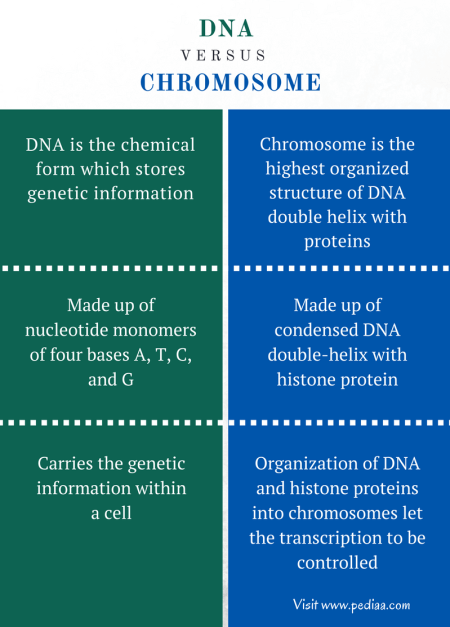Main Difference – DNA vs Chromosome
All known living organisms and many viruses utilize DNA as their genetic material in order to store their genetic information. DNA is a bivalent structure that exists as double-helix. DNA double-helix is condensed with histone proteins to form a chromosome. The key difference between DNA and chromosome is that DNA is the unorganized structure of the carrier of genetic information in most organisms and chromosome is the most organized structure of DNA with histones within a cell. Further, DNA stores the genetic instructions whereas chromosomes allow the gene regulation of a DNA strand.
This article explains,
1. What is DNA
– Definition, Structure, Features
2. What is a Chromosome
– Definition, Structure, Features
3. What is the difference between DNA and Chromosome

What is a DNA
DNA is the chemical form of storing the genetic information used in development, function, and reproduction. It is a macromolecule, composed of nucleotides as the monomer units. A nucleotide is built with a nitrogen base and a phosphate group which is attached to a phosphate sugar. Four different nitrogenous base types can be identified in DNA: cytosine (C), guanine (G), adenine (A) and thymine (T). The phosphate group of one nucleotide is attached to a sugar of another nucleotide via phosphodiester bonds to form the sugar-phosphate backbone. The polynucleotide stands are joined together by hydrogen bonds forming between two complement nitrogenous bases: A with T and C with G. Hence, double-stranded DNA is formed, each strand is complementary to the other strand. Also, the two strands run in opposite directions, making the strands antiparallel. Double-stranded DNA is coiled around each other to form the DNA double-helix.
DNA is organized into chromosomes for the easy package within the cell. The sequence of four bases along the DNA strand encodes the genetic information as genes. The size of the human genome is 3.2 billion base pairs. Humans have about 21,000 of genes. More than 98% of human DNA is composed of non-coding sequences whereas the other sequences are encoded for proteins. A few differences between the gene sequences make an individual identical. During cell division, the exact replica of original DNA is synthesized by replication.

Figure 1: DNA Structure
What is a Chromosome
A chromosome is the most organized structure of DNA. In eukaryotes, DNA double-helix is condensed with histone proteins to form nucleosomes. Nucleosome structure is further coiled into a fiber-like structure called chromatin fibers with a diameter of 250 nm. Chromatin is the normally existing form of DNA within the nucleus. They exhibit a thread-like structure and are less condensed compared to a chromosome. Chromatin is then further coiled to form chromosomes. The diameter of a chromosome is 30 nm. Chromosomes can be seen during the nuclear division event.
Eukaryotes consist of large, linear chromosomes whereas the prokaryotes consist of a single, circular chromosome condensed with histone-like proteins. Organization into chromosomes provides the structural integrity to DNA double-helix. A chromosome consists of thousands of genes. The accessibility to the sequence of the DNA at chromosomal level regulates the gene expression. Humans have 46 individual chromosomes. There are 22 homologous pairs of autosomes and 2 sex chromosomes. A chromosome also contains an origin of replication, centromere, and telomeres. Metaphase chromosomes of a cell are used to generate karyotypes for the analysis of chromosomal abnormalities.

Figure 2: DNA and Chromosome
Difference Between DNA and Chromosome
Definition
DNA: DNA is the chemical form which stores genetic information.
Chromosome: A chromosome is the highest organized structure of DNA double helix with proteins.
Content
DNA: DNA is made up of nucleotide monomers of four bases A, T, C, and G.
Chromosome: A chromosome is made up of condensed DNA double-helix with histone protein.
Function
DNA: DNA carries the genetic information within a cell.
Chromosome: Organization of DNA along with histone proteins into chromosomes let the transcription to be controlled.
Conclusion
DNA is the chemical form of storing genetic information for the development, functioning, and reproduction. Since DNA is a long strand it should be well packaged within the cell. Thus, DNA is condensed with histones to form chromosomes. Therefore, the key difference between DNA and chromosome is that a chromosome is the packaging structure of DNA.
Reference:
1. “DNA”. Wikipedia. Accessed 13 Feb. 2017
2. Rettner R., “DNA: Definition, Structure, and Discovery”. Live Science, 2013, Accessed 13 Feb. 2017.
3. Higgins N. P. “Chromosome Structure.” ENCYCLOPEDIA OF LIFE SCIENCES, Macmillan Publishers Ltd, Nature Publishing Group, 2001. Accessed 13 Feb.2017
Image Courtesy:
1. “DNA Overview landscape orientation”. By Michael Strock http://commons.wikimedia.org/wiki/File:DNA_Overview.png (CC-BY-SA-3.0) via Commons Wikimedia
2. “0321 DNA Macrostructure”. By OpenStax – (CC BY 4.0) via Commons Wikimedia

Leave a Reply